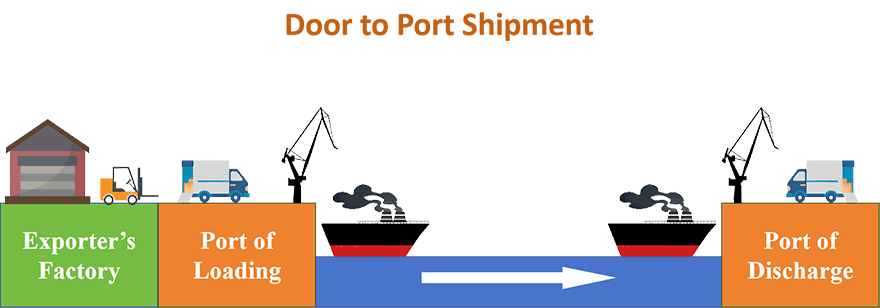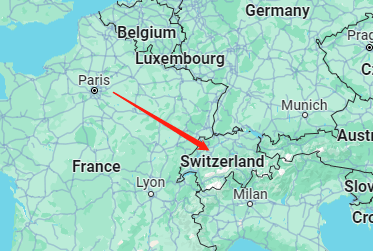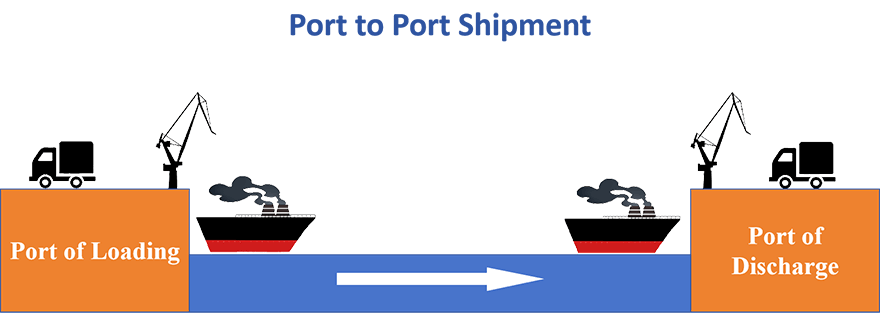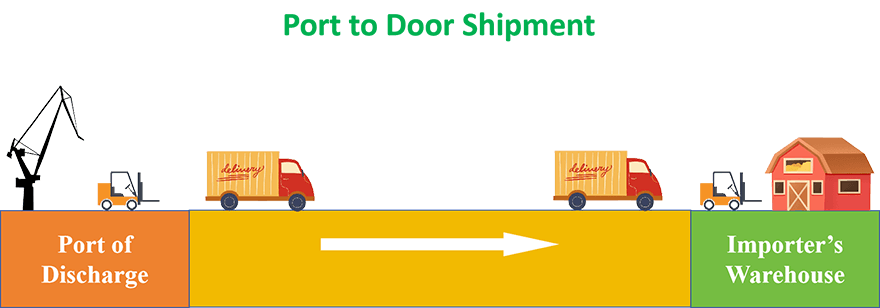After the completion of production for the goods you ordered in the exporting country, it’s time to consider the issue of international transportation. International trade involves lengthy transportation processes and utilizes various logistics methods. Today, this blog will help you understand four commonly used logistics terms that directly impact the entire transportation process, quotations, and the allocation of responsibilities at different stages. We believe that understanding these terms will assist you in your practical operations in international trade.
What is Door to Door?
Door to Door shipping refers to shipping from the seller’s warehouse to the buyer’s address, usually a warehouse. This mode of transportation provides great convenience to buyers, eliminating the need for them to handle logistics. Buyers only need to wait for the goods to be delivered to their warehouse.

Who Chooses Door to Door?
Due to its direct and convenient nature, Door to Door cargo shipping is an excellent choice for small-volume buyers or new buyers unfamiliar with international shipping. However, the convenience of one-stop services comes at a relatively higher cost.
Terms and Responsibility
Door-to-door international shipping is a commonly used term for practical trade, but not a formal trade term which is not typically used in official contracts. Door-to-door transportation services generally use DDP and DDU pricing.
In the case of DDP, the goods are directly delivered to the buyer’s warehouse, and the seller handles everything, including customs clearance in the buyer’s country and payment of taxes on behalf of the buyer. The seller assumes all risks and costs associated with this transportation process. The buyer’s role is to actively assist the seller in obtaining import permits or other necessary official documents for smooth customs clearance.
The difference between DDU and DDP lies in the fact that, in the DDU scenario, the seller, upon reaching the destination port, does not need to handle customs clearance and tax payments, nor does the seller bear the risks of the import clearance process – these are handled by the buyer’s freight forwarder.
Door to Door Pricing
Door to Door delivery includes most or all expenses from the seller’s warehouse to the buyer’s specified location. Let me illustrate with an example. Suppose you are a buyer from New York, USA, purchasing 2000 cups from Yiwu, China, and shipping them to your warehouse in New York. Typically, goods from Yiwu would be transported to the nearest port, Ningbo Port.
Under DDP terms, the seller would provide you with the unit price of cups and the total freight cost. For instance, if the cup’s unit price is $5, and the total freight cost from Yiwu to your warehouse is $20,000, this $20,000 freight cost would mainly cover:
- Cost from the factory to Ningbo Port
- Export customs clearance fees
- Ocean freight from Ningbo Port to New York Harbor
- Import customs clearance fees
- Customs duties or value-added taxes
- Cost from New York Harbor to the warehouse
- Other associated fees
Therefore, your DDP price is calculated as the product unit price multiplied by the quantity (in this case, 2000 cups) plus the total freight cost, resulting in $30,000.
What is Door to Port?
Door to Port shipping generally refers to the process of transporting goods from the seller’s warehouse to the destination port. The key distinction between Door to Port and door to door is that door-to-port requires buyers to handle import customs clearance and domestic shipping by themselves.

Who chooses Door to Port?
When the buyer has the ability to arrange for customs clearance and inland transportation in the importing country, they can choose door-to-port transportation.
Or when your seller has a hard time finding a freight forwarder to deliver your goods to your warehouse, then door-to-port shipping is sometimes a necessary option.
For example, if you are a Swiss buyer who buys a batch of goods from China and wants to ship directly to the door, but China is very short of freight forwarders who specialize in door-to-door transportation from China to Switzerland, because Switzerland rarely imports goods directly from China, and many of its daily consumer goods are from the surrounding Germany, the Netherlands, France and other countries purchase, and Switzerland does not have a sea port, generally only through the neighboring countries of the nearest port to pick up the goods, at this time, you can only choose to let the seller transport the goods from China to a neighboring country such as a port in France, and you pick up the goods from the port yourself.

Door to Port Incoterms and Pricing
Door-to-port transportation can be priced using CIF (Cost, Insurance, and Freight) terms.
Under CIF terms, the seller is responsible for transporting the goods from the seller’s warehouse to the destination port. The inclusive price covers product cost, insurance, freight, and miscellaneous fees. Miscellaneous fees encompass export customs duties, inland transportation costs, and other charges. However, the seller does not bear the risk of the goods during the sea transit.
What is Port to Port?
Port to Port shipping refers to transporting goods from the origin port (loading port) to the destination port (unloading port). Since carriers are not responsible for inland transportation at either end, buyers should have a specific plan to execute various processes before leaving the origin port. On the flip side, buyers have better control over the transportation and can flexibly choose logistics partners they trust.

Trade Terms and Responsibility
There are various trade terms available for port-to-port shipping, such as CFR, CIF, CPT, CIP, DDP, DAP and DAT. Among them, CIF and CFR are the most commonly used.
CIF, which stands for Cost, Insurance, and Freight, includes product cost, insurance, and freight charges. Under this term, the seller is responsible for all export procedures and is obligated to transport the goods to the destination port. However, the seller is not accountable for the safety of the goods during sea transit. Once the goods arrive at the destination port, the buyer takes over customs clearance and further transportation to the final destination.
CFR, or Cost and Freight, covers product cost and freight charges, The key distinction between CFR and CIF lies in the absence of insurance coverage in CFR.
Port to Port Pricing
Port-to-port is just one part of the overall international transportation.The actual cost depends on the applied trade terms and specific trade scenarios. For example, if you are a buyer in Los Angeles importing T-shirts from Yiwu, China, the CIF quote would mainly include
- product cost
- expenses from Yiwu to Ningbo Port
- export customs clearance fees
- ocean freight from Ningbo Port to Los Angeles Port (mainly depends on port-to-port distance)
- Insurance
What is Port to Door?
Port to Door transportation is usually the transportation from the destination port to buyer’s warehouse.

Port to Door Incoterms and Pricing
Two common terms used in Port to Door shipping are CPT (Carriage Paid To) and DDP (Delivered Duty Paid).
Under CPT, the seller should transport the goods from the destination port to the buyer’s address. During this process, the buyer should be responsible for the import clearance and its costs.
DDP, on the other hand, means Delivered Duty Paid, where the seller must deliver the goods to the buyer’s specified location, such as their warehouses. All costs from the port to the buyer’s warehouse are borne by the seller, including import customs clearance fees and inland transportation fees.
You need to note that although port-to-door shipping is only a small part of the overall international transportation, its price may be more expensive than you can imagine, and the main mode of port-to-door transportation is generally road transportation, which can sometimes be much more expensive than the cost of sea freight over long distances. So people usually try to reduce the distance of this transportation to save costs.
Summary
These four logistics terms are very commonly used in actual international trade, and I hope they will help you.
We are Jingsourcing, a leading sourcing company in China. We are committed to sourcing and customizing all kinds of products from China and arranging the best shipping options. We have reliable supplier resources and long-term cooperative freight forwarders. We can provide the best solution to any problem that is sourced from China. Please CONTACT US.

Leave A Comment